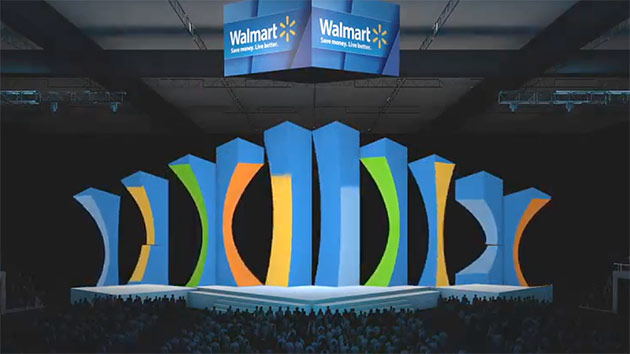On Projection Mapping: Past, Present, and Future
Based in Nashville, TN, Rabbit Hole Creative prides itself on a prodigious combination of creative thinking and technical chops. Its blend of expertise allows it to mount impressive spectacles for entertainment and corporate clients using projection-mapping technology to simulate a 3D environment using animations crafted for a specific shaped screen. (For a closer look at a projection-mapping project, see the Mutemath case study we published last year.) We asked Rabbit Hole President Kevin Fulda Five Questions about technique, technology, and what's coming up next. Watch the video to see an example of projection mapping in use for a Wal-mart shareholders' meeting, then read the Q&A below.
Projection mapping is one of Rabbit Hole's specialties. How did you become experts in this realm?
- Experience
- Patience
- Thousands of hours of research, development, trial and error
- We have a diverse team of experts in their craft. Projection mapping requires expert designers, engineers, software developers, projectionists, and media server operators. The secret is bringing the absolute best people together and figuring out how to best communicate across disciplines. If you can do this, you can execute a project flawlessly every time.
How different is the creative skill set required in projection mapping compared to traditional motion design and animation work?
The skill set is similar. A lot of the same tools and applications are used. The difference is the approach and the way you leverage the tools. Also, having the experience to know how what you are creating will translate from the computer screen to projection is extremely important.
What software tools become more essential when you're developing and executing these projects?
3D design software is imperative. We use it from ideation through content creation. We have workflows in our 3D software to build a scenic or projection surface, create an extremely accurate projection design (this tells us exactly where and how to rig the projectors and which lensing to use), to previsualize the show, check resolution, brightness, and shadows, and of course for content creation specifically: modeling, texturing, lighting, rigging and animation.
We've seen projection mapping employed at rock concerts, in churches, at corporate events, and also in what could be described as outdoor art installations. Do you see other applications emerging in the future?
Projection mapping has been used heavily in the past for mapping products such as shoes and smartphones. In most cases, these promotions were created for the purpose of making eye-catching videos. Now, with the advent of more interactive technologies and real-time rendering, product projection mappings will come to the hands of the consumer, allowing consumers to interact with installations that are either in-store or for activation campaigns.
What's the next big technological development you're waiting for that will allow you to take digital media projects to a new level?
There is a lot of exciting new technology emerging. I'm fascinated with integrating all types of new technology to dream up new ways to experience and interact with our physical world. I'm most excited about the future of head-mounted displays, real-time rendering, 3D tracking, and haptic feedback. All of these technologies help broaden and enrich an augmented reality experience.
Sections: Business
Topics: Q&A projection mapping rabbit hole creative wal-mart
Did you enjoy this article? Sign up to receive the StudioDaily Fix eletter containing the latest stories, including news, videos, interviews, reviews and more.

You can create video and projection mappings very easily with software like TABULA FaçadeSignage.
http://www.videomappingsoftware.com